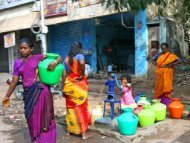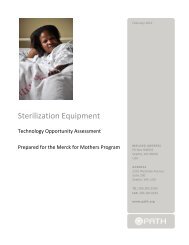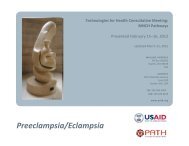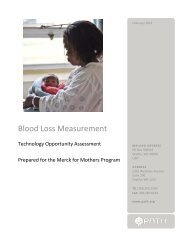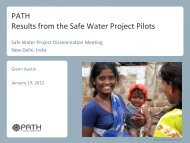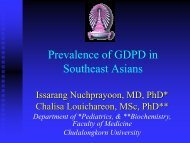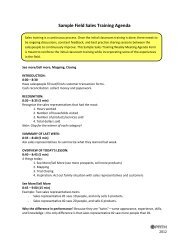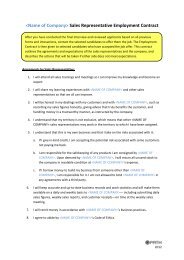Key Messages on Rotavirus Vaccines for NIP Managers* - Path
Key Messages on Rotavirus Vaccines for NIP Managers* - Path
Key Messages on Rotavirus Vaccines for NIP Managers* - Path
You also want an ePaper? Increase the reach of your titles
YUMPU automatically turns print PDFs into web optimized ePapers that Google loves.
<str<strong>on</strong>g>Key</str<strong>on</strong>g> <str<strong>on</strong>g>Messages</str<strong>on</strong>g> <strong>on</strong> <strong>Rotavirus</strong> <strong>Vaccines</strong> <strong>for</strong> <strong>NIP</strong> <strong>Managers*</strong><br />
April 2013<br />
General<br />
• <strong>Rotavirus</strong> is the leading cause of severe and fatal diarrhoea in children worldwide (~36% of diarrhoea<br />
hospitalisati<strong>on</strong>s in children under five-years old are due to rotavirus). 1 More than 90% of rotavirus<br />
deaths occur in developing countries where access to treatment is limited or unavailable. 2<br />
• No specific therapy currently available such as antibiotics is effective against rotavirus. As with other<br />
childhood diarrhoeas, the cornerst<strong>on</strong>es of treatment <strong>for</strong> rotavirus are fluid replacement to prevent<br />
dehydrati<strong>on</strong> and zinc treatment, which decreases the durati<strong>on</strong> and severity of diarrhoea. 3<br />
• <strong>Rotavirus</strong> vaccinati<strong>on</strong> is the best way to prevent this highly c<strong>on</strong>tagious disease. 3 <strong>Rotavirus</strong> remains<br />
comm<strong>on</strong> even in industrialised countries with clean water and sanitati<strong>on</strong>. 4 Without vaccinati<strong>on</strong>, nearly<br />
all children will have rotavirus infecti<strong>on</strong> by three to five years of age. About 80% of children born in low<br />
income countries have been infected by rotavirus by 12 m<strong>on</strong>ths of age. 5<br />
• Many countries that have introduced rotavirus vaccine have experienced substantial reducti<strong>on</strong>s in<br />
hospitalisati<strong>on</strong>s and deaths due to rotavirus and all-cause diarrhoea. 3,6<br />
• Two rotavirus vaccines are prequalified by the World Health Organizati<strong>on</strong> (WHO): Merck’s RotaTeq®<br />
(RV5) and GlaxoSmithKline’s Rotarix® (RV1).<br />
• <strong>Rotavirus</strong> vaccine is given with other infant vaccines (usually at 6, 10, and 14 weeks) with RV5 requiring<br />
three doses and RV1 requiring two doses. WHO c<strong>on</strong>siders both vaccines similarly safe and effective.<br />
• Price, availability, packed volume and vaccine vial m<strong>on</strong>itor (VVM) in<strong>for</strong>mati<strong>on</strong> are in the GAVI Product<br />
Menu; 7 and data <strong>on</strong> each vaccine is available <strong>on</strong> WHO’s website of prequalified vaccines. 8<br />
• The use of rotavirus vaccine should be part of a comprehensive diarrhoea programme that includes<br />
scaling up of preventi<strong>on</strong> (early and exclusive breastfeeding, hand-washing with soap, improved water<br />
supply and sanitati<strong>on</strong>) and treatment with oral rehydrati<strong>on</strong> soluti<strong>on</strong> (ORS) and zinc. 3,9<br />
Timing and Risks<br />
• Introducti<strong>on</strong> of rotavirus vaccine should be used to improve immunisati<strong>on</strong> coverage and timeliness.<br />
• Timely immunisati<strong>on</strong> is vital, as a vaccine can <strong>on</strong>ly protect if given be<strong>for</strong>e infecti<strong>on</strong>; this is especially<br />
critical <strong>for</strong> rotavirus vaccine, as infecti<strong>on</strong>s can start from the first weeks of life, and children under 6<br />
m<strong>on</strong>ths are particularly vulnerable to rotavirus infecti<strong>on</strong>. 10<br />
• <strong>Rotavirus</strong> vaccines are safe, with most children having no or mild reacti<strong>on</strong>s; the <strong>on</strong>ly known serious<br />
adverse event following immunisati<strong>on</strong> (AEFI) is intussuscepti<strong>on</strong>, a very rare type of bowel blockage (1-2<br />
cases per 100,000 vaccinated infants).<br />
• Because the risk of intussuscepti<strong>on</strong> is age-related, peaking at about 6 m<strong>on</strong>ths of age, WHO initially<br />
recommended upper age limits of 15 weeks and 32 weeks <strong>for</strong> first and last doses, respectively. 11<br />
Following a review of new evidence in 2012, WHO recommended removing the strict age limits <strong>for</strong><br />
rotavirus vaccinati<strong>on</strong>. 3<br />
• WHO c<strong>on</strong>tinues to recommend that every infant receives his/her first dose of rotavirus vaccine as<br />
so<strong>on</strong> as possible after 6 weeks of age al<strong>on</strong>g with vaccinati<strong>on</strong> against diphtheria-tetanus-pertussis (DTP)<br />
and subsequent doses as closely to the nati<strong>on</strong>al immunisati<strong>on</strong> schedule as possible. 3<br />
• WHO recommends that RV1 should be administered orally in a 2-dose schedule at the time of DTP1 and<br />
DTP2 with an interval of at least 4 weeks between doses. RV5 should be administered orally in a 3-dose<br />
schedule at the time of the DTP1, DTP2, and DTP3 with an interval of at least 4 weeks between doses.<br />
Page 1 of 3
With both vaccines, prematurely born infants should follow the vaccinati<strong>on</strong> schedules recommended <strong>for</strong><br />
their chr<strong>on</strong>ological age. 3<br />
• The benefits from preventing rotavirus deaths through vaccinati<strong>on</strong> are much greater than the possible<br />
risk of intussuscepti<strong>on</strong>. 12 Due to the typical age distributi<strong>on</strong> of rotavirus infecti<strong>on</strong>, there is unlikely to be<br />
much benefit from vaccinating children above two years of age with rotavirus vaccine. 3,13<br />
Administrati<strong>on</strong> of Vaccine<br />
• <strong>Rotavirus</strong> vaccine prevents severe rotavirus diarrhoea but does not prevent diarrhoea caused by other<br />
pathogens. Thus, when a vaccinator gives rotavirus vaccine, it is a crucial opportunity to remind<br />
caregivers about (1) other healthy acti<strong>on</strong>s to prevent diarrhoea—especially breast-feeding and handwashing<br />
with soap; (2) home treatment of diarrhoea with ORS and zinc; (3) how to recognise danger<br />
signs of intussuscepti<strong>on</strong> or severe dehydrati<strong>on</strong> and when to seek health care. 14<br />
• The vaccinator must remind the caregiver of the need <strong>for</strong> timely completi<strong>on</strong> of the immunisati<strong>on</strong><br />
schedule <strong>for</strong> all vaccines and the date of the child’s next visit.<br />
• <strong>Rotavirus</strong> vaccine is given orally, with a volume of 1.5 or 2 ml — depending <strong>on</strong> the product—through a<br />
nozzle that has to pass through the lips and be delivered <strong>on</strong> the inside of the cheek (as compared to <strong>on</strong>ly<br />
two drops of oral polio vaccine (OPV) that fall into the open mouth).<br />
• For Rotarix®, it is important to open the vaccine tube correctly—reverse and twist cap to open; do not<br />
snap off—to prevent the small nozzle being dropped into the tube and possibly ingested by the child. 15<br />
Reaching the Most Vulnerable<br />
• The poorest, most vulnerable children with limited access to treatment have the most to gain from<br />
rotavirus vaccine; special ef<strong>for</strong>ts to reach these children <strong>on</strong> schedule will maximise impact of rotavirus<br />
vaccine. 16<br />
• Communities with infants who are currently un- or under-vaccinated are the <strong>on</strong>es with most to benefit<br />
from rotavirus vaccine. Special focus <strong>on</strong> reaching these populati<strong>on</strong>s should be part of rotavirus vaccine<br />
introducti<strong>on</strong> planning. 9<br />
• For communities reached four times (or less) per year with immunisati<strong>on</strong> services, timely vaccinati<strong>on</strong> is<br />
not feasible. As under-served communities tend to be at greatest risk of death from deadly dehydrating<br />
rotavirus diarrhoea, additi<strong>on</strong>al ef<strong>for</strong>ts to provide more frequent immunisati<strong>on</strong> sessi<strong>on</strong>s would be<br />
beneficial, if possible.<br />
Additi<strong>on</strong>al <strong>Rotavirus</strong> Communicati<strong>on</strong>, Training, and In<strong>for</strong>mati<strong>on</strong> Resources<br />
• GAVI – rotavirus new vaccine support http://www.gavialliance.org/support/nvs/rotavirus/<br />
• PATH – rotavirus advocacy and communicati<strong>on</strong> toolkit (available in English and French)<br />
http://sites.path.org/rotavirusvaccine/rotavirus-advocacy-and-communicati<strong>on</strong>s-toolkit/<br />
• PATH’s RotaFlash – e-news alert that provides breaking scientific news and updates <strong>on</strong> progress<br />
made toward increasing access to vaccines against rotavirus<br />
http://sites.path.org/rotavirusvaccine/current-issue-of-rotaflash-jpg/<br />
• UNICEF – Communicati<strong>on</strong> Framework <strong>for</strong> New <strong>Vaccines</strong> and Child Survival<br />
https://sites.google.com/site/commframe/<br />
• US Centers <strong>for</strong> Disease C<strong>on</strong>trol and Preventi<strong>on</strong> (CDC) - rotavirus in<strong>for</strong>mati<strong>on</strong><br />
http://www.cdc.gov/rotavirus/index.html<br />
• WHO – rotavirus in<strong>for</strong>mati<strong>on</strong> and resources http://www.who.int/nuvi/rotavirus/en/<br />
Page 2 of 3
*”<str<strong>on</strong>g>Key</str<strong>on</strong>g> <str<strong>on</strong>g>Messages</str<strong>on</strong>g> <strong>on</strong> <strong>Rotavirus</strong> <strong>Vaccines</strong> <strong>for</strong> <strong>NIP</strong> Managers” was prepared by the <strong>Rotavirus</strong> Communicati<strong>on</strong>s<br />
Working Group, a partnership of WHO, UNICEF, GAVI, PATH, JSI, MCHIP, and USAID.<br />
References<br />
1 WHO. Global <strong>Rotavirus</strong> In<strong>for</strong>mati<strong>on</strong> and Surveillance Bulletin Volume 6: October 2012 Reporting period: January to<br />
December 2011. http://www.who.int/nuvi/rotavirus/RV_bulletin_Jan_Dec_2011_FINAL.pdf<br />
2 Tate JE, Burt<strong>on</strong> AH, Boschi-Pinto C, et. al. 2008 estimate of worldwide rotavirus-associated mortality in children<br />
younger than 5 years be<strong>for</strong>e the introducti<strong>on</strong> of universal rotavirus vaccinati<strong>on</strong> programmes: a systematic review and<br />
meta-analysis. The Lancet Infectious Diseases. 2012;12(2):136–141.<br />
http://www.thelancet.com/journals/laninf/article/PIIS1473-3099(11)70253-5/abstract<br />
3 <strong>Rotavirus</strong> vaccines: WHO positi<strong>on</strong> paper. Weekly Epidemiological Record. No. 5, 2013, 88, 49–64. 2013.<br />
http://www.who.int/entity/wer/2013/wer8805.pdf [N.B. 2013 WHO <strong>Rotavirus</strong> positi<strong>on</strong> paper replaces 2007 WHO<br />
rotavirus positi<strong>on</strong> paper <strong>Rotavirus</strong> vaccines: WHO positi<strong>on</strong> paper. Weekly Epidemiological Record.2007; 82(32): 285-<br />
296. http://www.who.int/wer/2007/wer8232.pdf and 2009 update <strong>Rotavirus</strong> vaccines: an update. Weekly<br />
Epidemiological Record. 2009;84(50):533–540. http://www.who.int/wer/2009/wer8451_52.pdf)]<br />
4 Yen C, Tate JE, Patel MM, et al. <strong>Rotavirus</strong> vaccines: update <strong>on</strong> global impact and future priorities. Human <strong>Vaccines</strong>.<br />
2011;7(12): 1282–1290. www.landesbioscience.com/journals/13/article/18321/ [subscripti<strong>on</strong>].<br />
5 Sanders<strong>on</strong> C et al (2011) Global review of rotavirus morbidity and mortality data by age and WHO regi<strong>on</strong>. Report to<br />
WHO/IVB. http://www.who.int/immunizati<strong>on</strong>/sage/meetings/2012/april/Sanders<strong>on</strong>_et_al_SAGE_April_rotavirus.pdf<br />
6 Patel M, Steele AD, Gentsch JR, Wecker J, Glass RI, Parashar UD. Real‐world impact of rotavirus vaccinati<strong>on</strong>. Pediatric Infectious<br />
Disease Journal. 2011;30(1):S1–S34.<br />
http://journals.lww.com/pidj/Fulltext/2011/01001/Real_world_Impact_of_<strong>Rotavirus</strong>_Vaccinati<strong>on</strong>.1.aspx.<br />
7 Product Menu <strong>for</strong> <strong>Vaccines</strong> Supplied by UNICEF <strong>for</strong> GAVI. http://www.unicef.org/supply/index_gavi.html<br />
8 WHO prequalified vaccines.<br />
http://www.who.int/immunizati<strong>on</strong>_standards/vaccine_quality/PQ_vaccine_list_en/en/index.html<br />
9 UNICEF and WHO. Integrated Global Acti<strong>on</strong> Plan <strong>for</strong> Preventi<strong>on</strong> and C<strong>on</strong>trol of Pneum<strong>on</strong>ia and Diarrhoea (GAPPD).<br />
April 2013. (English and French versi<strong>on</strong>s)<br />
http://www.who.int/maternal_child_adolescent/documents/global_acti<strong>on</strong>_plan_pneum<strong>on</strong>ia_diarrhoea/en/index.html<br />
10 <strong>Rotavirus</strong>. Epidemiology and Preventi<strong>on</strong> of Vaccine-Preventable Diseases. The Pink Book: Course Textbook - 12th<br />
Editi<strong>on</strong> Sec<strong>on</strong>d Printing (May 2012). http://www.cdc.gov/vaccines/pubs/pinkbook/rota.html<br />
11 <strong>Rotavirus</strong> vaccines: an update. Weekly Epidemiological Record. 2009;84(50):533–540.<br />
http://www.who.int/wer/2009/wer8451_52.pdf<br />
12 Patel MM, Clark AD, Sanders<strong>on</strong> CFB, Tate J, Parashar UD. Removing the Age Restricti<strong>on</strong>s <strong>for</strong> <strong>Rotavirus</strong> Vaccinati<strong>on</strong>: A<br />
Benefit-Risk Modeling Analysis. PLOS Medicine. 2012;9(10):e1001330.<br />
http://www.plosmedicine.org/article/info%3Adoi%2F10.1371%2Fjournal.pmed.1001330<br />
13 Meeting of the Strategic Advisory Group of Experts <strong>on</strong> immunizati<strong>on</strong>, April 2012 – c<strong>on</strong>clusi<strong>on</strong>s and recommendati<strong>on</strong>s.<br />
Weekly Epidemiological Record. 2012;87(21):201-216. http://www.who.int/wer/2012/wer8721.pdf<br />
14 WHO/UNICEF Integrated Management of Childhood Illness (IMCI) Handbook.<br />
http://whqlibdoc.who.int/publicati<strong>on</strong>s/2005/9241546441.pdf<br />
15 See WHO’s training module 4 “<strong>Rotavirus</strong> Vaccine Administrati<strong>on</strong>.”<br />
http://www.who.int/entity/nuvi/rotavirus/RotaTrainingPackage_Mod4_28Feb.ppt<br />
16 Rheingans R, Atherly DE, Anders<strong>on</strong> J. Distributi<strong>on</strong>al impact of rotavirus vaccinati<strong>on</strong> in 25 GAVI countries: Estimating<br />
disparities in benefits and cost-effectiveness. Vaccine. 2012;30(1):A15–A23).<br />
http://www.sciencedirect.com/science/article/pii/S0264410X12000333<br />
Page 3 of 3



